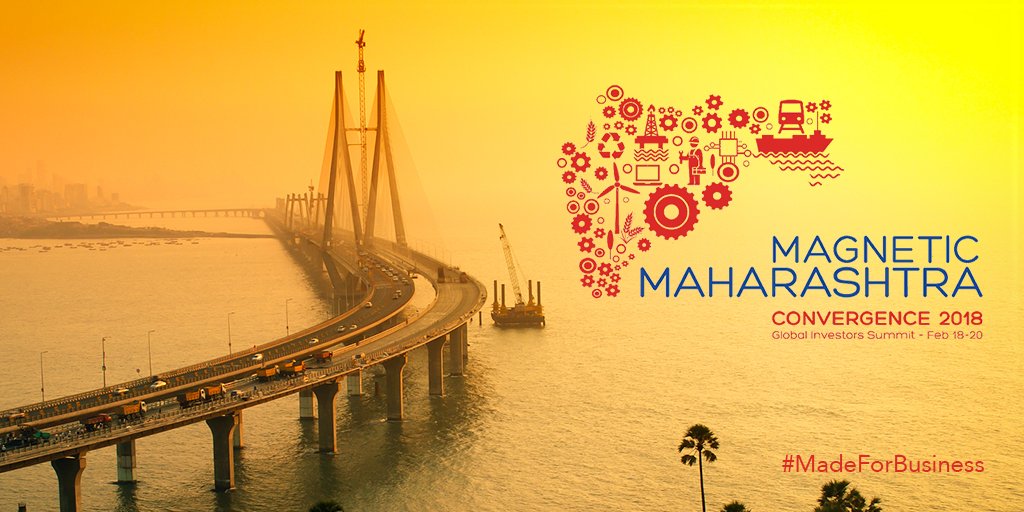First Global Summit in Maharashtra
To tap foreign investment, set up a robust manufacturing base, boost ‘Make in India’, and also generate employment opportunities, Maharashtra recently unveiled the ‘Magnetic Maharashtra’ policy.
Indian Prime Minister Narendra Modi will inaugurate the three-day conclave called ‘Magnetic Maharashtra: Convergence 2018’, which will take place from February 18 to 20. The sectors being tapped for global partnership through Delhi-Mumbai Industrial Corridor (DMIC) are: Information Technology, Food Processing, Logistic hubs, Electronic hubs and Automobile industries.
As Maharashtra witnesses social unrest and an acute agrarian crisis, the Devendra Fadnavis’ (Chief Minister of Maharashtra) government is looking to enter into agreements entailing investments of over $160 billion at the investors’ summit next week.
Besides home-grown business tycoons, such as Mukesh Ambani and Anand Mahindra, Virgin Atlantic Group founder and chairman, Richard Branson will be among the hosts of business leaders who will be attending the Summit.
The Magnetic Maharashtra policy was unveiled recently to attract investments of $2 billion with a unique model to create five defence manufacturing hubs near military bases in the state. Maharashtra also hopes to create 100 000 jobs in five years. Will the foreign investors respond positively, is the question.
Maharashtra has planned the defence and aerospace-manufacturing hubs in Nagpur, Pune, Aurangabad, Ahmednagar and Nashik. All these five cities have significant military establishments, which will enable them to create adequate demand. Nagpur already has maintenance, repair and overhaul facilities. The Policy hopes to leverage and develop the city as a global manufacturing hub.
The Magnetic Maharashtra policy has to be seen in the recent effort of the federal government to promote defence hubs across India. Presenting the annual federal budget, Finance Minister Arun Jaitley has proposed a defence corridor that will connect the electronic hub of Bengaluru with the engineering hub of Chennai – the first of the two defence production corridors.
Why this emphasis on defence hubs?
Many countries spend between 2 to 2.5 pc of their gross domestic product (GDP) on defence. India’s defence budget for the year 2017–18 was 1.63 pc of GDP—the lowest in the past 50-odd years in terms of percentage of GDP, while India’s two hostile neighbours, China and Pakistan, consistently spend over 2 pc of their GDP on defence.
Also, budgetary allocations go to revenue expenditure and the balance is left for capital acquisition. After the implementation of the 7th Central Pay Commission (CPC) and One Rank One Pay (OROP), revenue expenditure during the last few years has increased. This leaves little for capital expenditure. Considering the committed liabilities arising out of the contracts already signed, the amount of money available for new projects is a measly $1,3 billion for the year 2017-18 (out of a total defence budget of $40 billion). Consequently, this leaves only 3.6pc of the defence budget available for the modernisation of all three Armed Forces for an entire year, even as they already face shortfall of equipment.
The global defence industry is growing by three to four percent and the Indian market is growing by over 10 percent. The Union Government currently relies on imports for 70 percent of its defence needs and it wants to cut this by 30 pc, which will encourage domestic production.
With grand intentions of self-reliance in defence manufacturing, India has already undertaken reforms in the arms procurement procedures. While the policymakers are upbeat about the possibility of huge investments, experts opine that it all depends on the foreign investors. According to defence-sector observers, magnetic Maharashtra has integrated the islands of excellence into a cohesive defence hub. But its success will depend on attracting global defence manufacturers.
Says Col K V Kuber, CEO Sugosha Advisory, specializing in aerospace and defence consultancy: “Pune has DRDO establishments and design houses. Nagpur has emerged as a defence hub, thanks to the presence of original equipment manufacturers, such as Boeing, Dassault-Reliance.”
“Therefore, the success of magnetic Maharashtra will depend on attracting global original equipment manufacturers (OEMs) that will not only bring fresh investment but will also build the ecosystem.”










